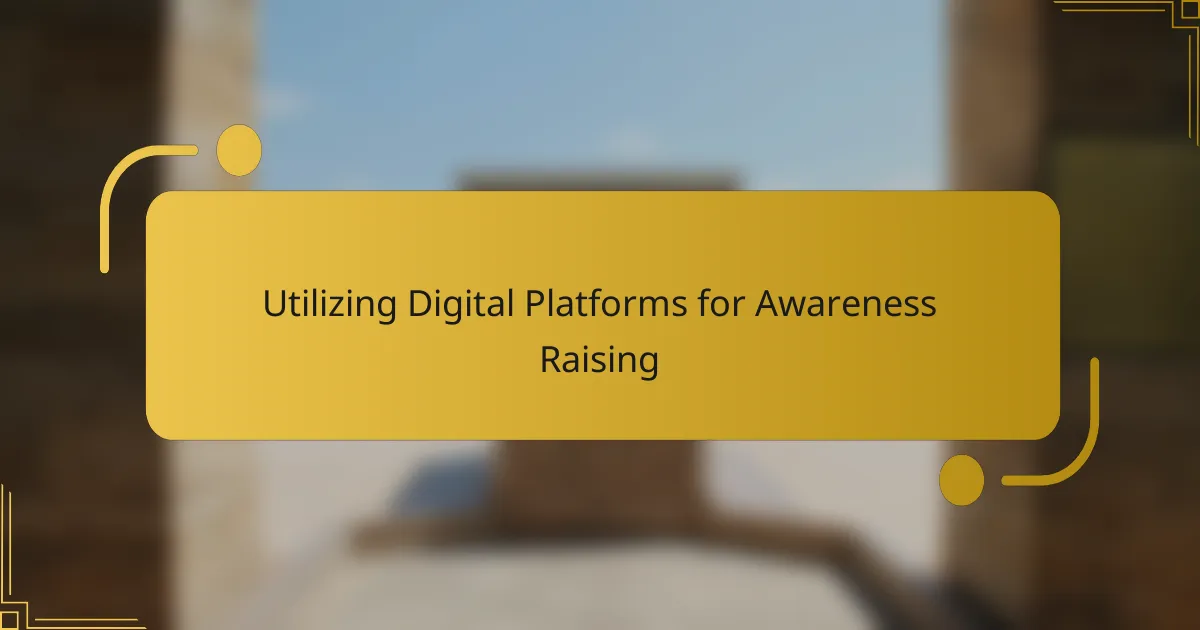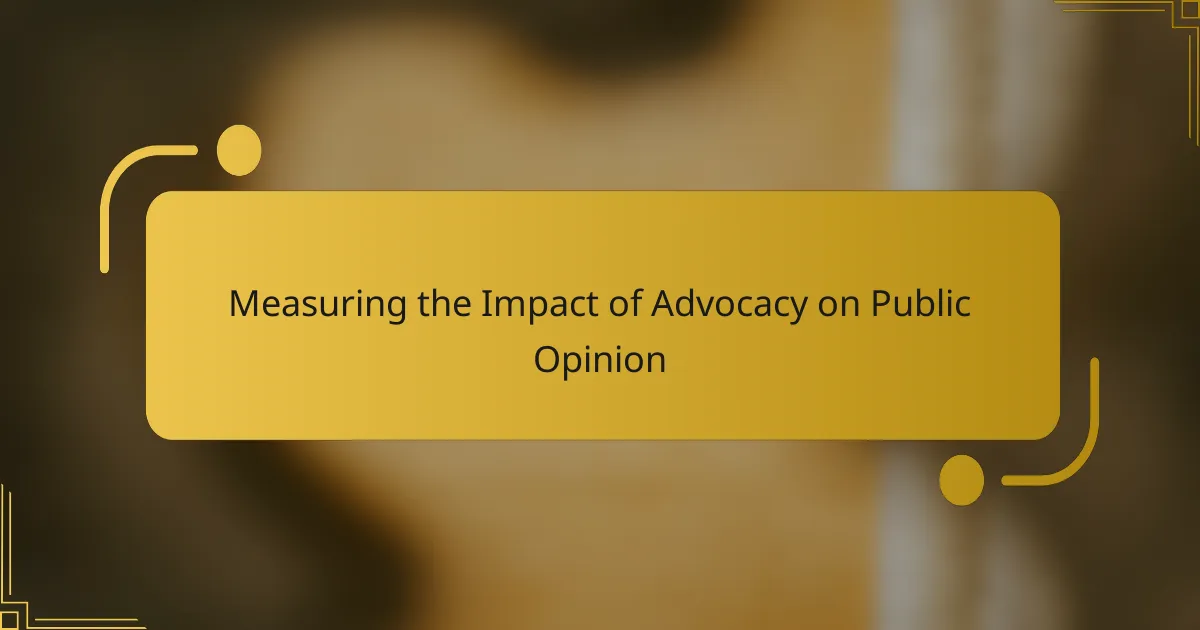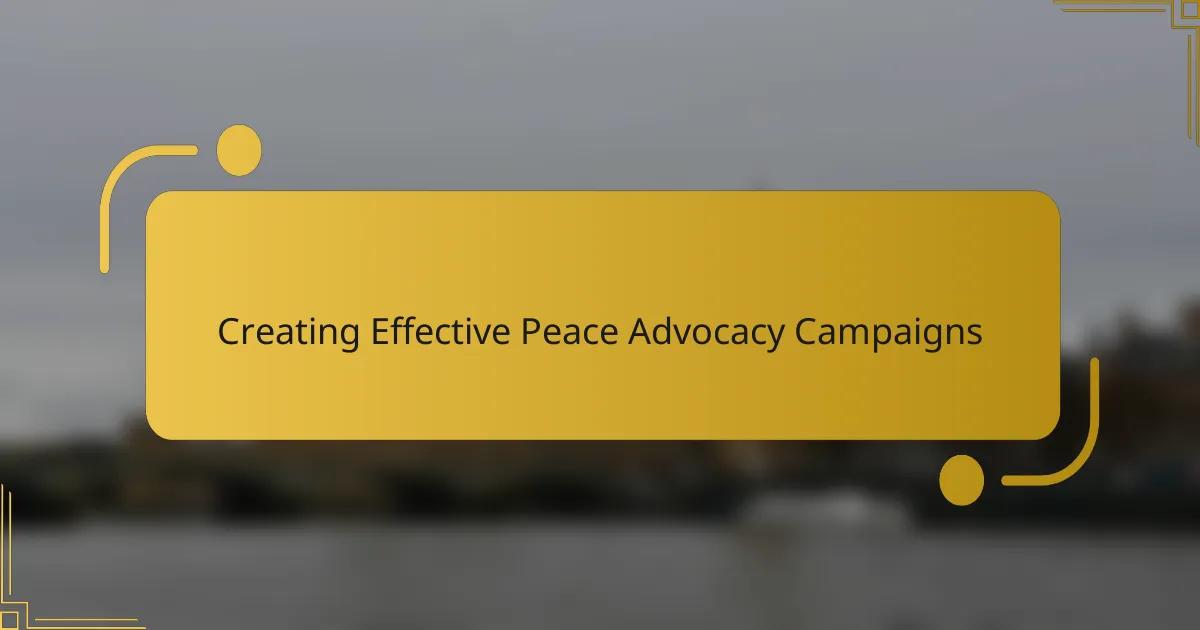Digital platforms play a crucial role in raising awareness within communities by enabling effective communication and engagement on pressing issues. By leveraging these tools, organizations can disseminate information rapidly and reach a wide array of audiences, enhancing their visibility and impact.
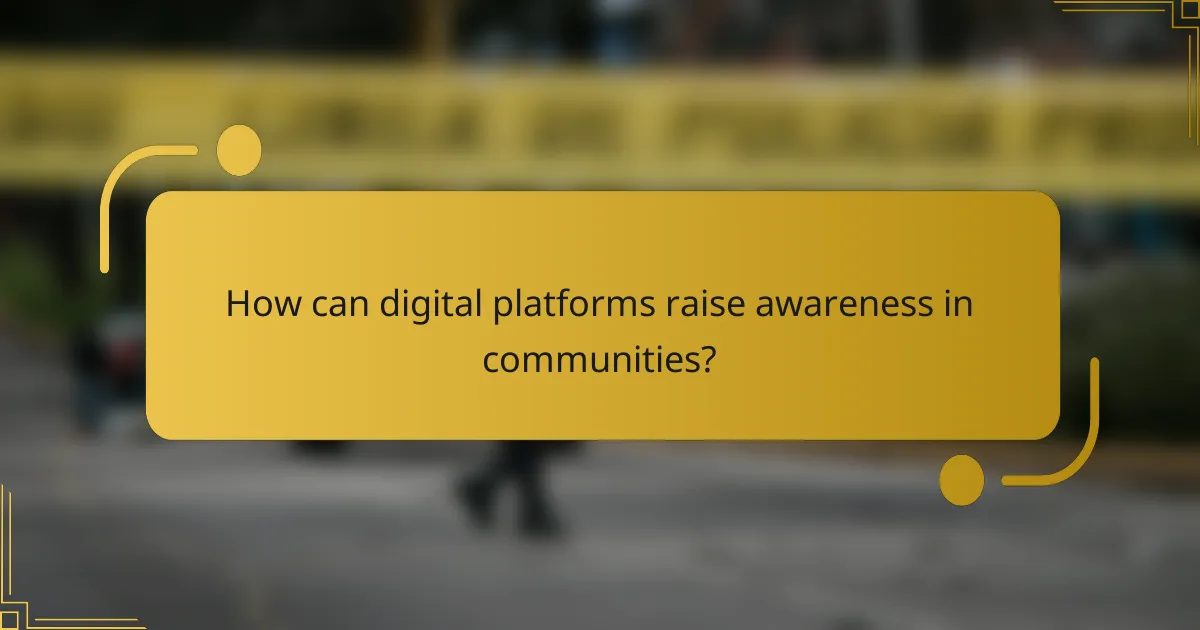
How can digital platforms raise awareness in communities?
Digital platforms can significantly raise awareness in communities by facilitating communication and engagement on important issues. They provide tools for sharing information quickly and broadly, allowing organizations to reach diverse audiences effectively.
Social media campaigns
Social media campaigns leverage platforms like Facebook, Twitter, and Instagram to engage users and spread awareness. By creating shareable content, organizations can tap into existing networks and encourage community members to participate in discussions or events.
To maximize impact, use eye-catching visuals and clear calls to action. Consider running targeted ads to reach specific demographics, which can enhance engagement and participation rates.
Email marketing strategies
Email marketing remains a powerful tool for raising awareness by delivering tailored messages directly to subscribers. Regular newsletters can keep communities informed about initiatives, events, and opportunities for involvement.
When crafting emails, focus on compelling subject lines and concise content. Segment your audience to ensure that messages are relevant, and include clear links to further information or actions.
Online webinars and workshops
Online webinars and workshops provide interactive platforms for education and discussion, allowing communities to engage with experts and each other. These events can cover various topics, from local issues to broader societal challenges.
Promote these events through social media and email to maximize attendance. Ensure that sessions are accessible and consider recording them for future viewing to reach a wider audience.
Influencer partnerships
Collaborating with local influencers can amplify awareness efforts by leveraging their established trust and reach within the community. Influencers can share messages and promote events, making them more relatable to their followers.
Choose influencers whose values align with your cause and who have a genuine connection to the community. This authenticity can enhance the effectiveness of your awareness campaigns.
Content marketing initiatives
Content marketing involves creating valuable, informative content that addresses community needs and interests. This can include blog posts, videos, and infographics that educate and engage audiences about specific issues.
Focus on quality and relevance to ensure that the content resonates with your target audience. Distributing this content through social media and email can further enhance its reach and impact.
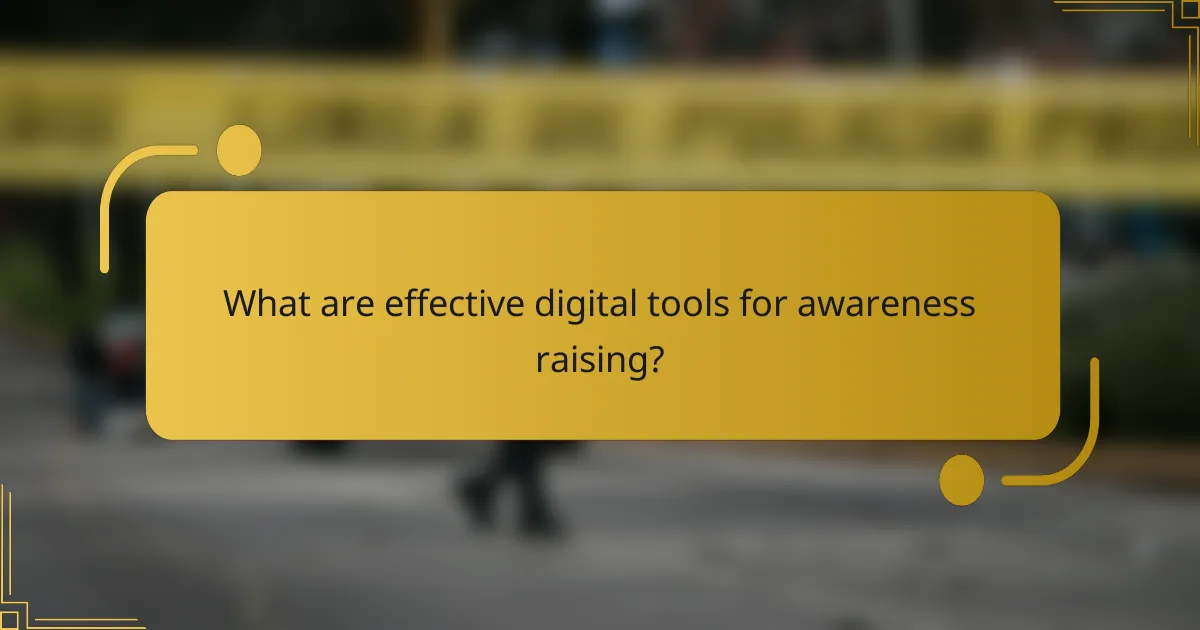
What are effective digital tools for awareness raising?
Effective digital tools for awareness raising include platforms that allow targeted outreach and engagement with specific audiences. Utilizing these tools strategically can significantly enhance visibility and impact.
Facebook Ads
Facebook Ads provide a robust platform for awareness raising due to their extensive user base and detailed targeting options. You can create campaigns that reach specific demographics based on interests, location, and behaviors, making it easier to connect with your target audience.
To maximize effectiveness, consider using eye-catching visuals and clear calls to action. Set a budget that aligns with your goals, and monitor performance metrics to adjust your strategy as needed.
Google Ads
Google Ads enables organizations to promote their messages through search results and display networks. By bidding on relevant keywords, you can ensure your content appears when users search for related topics, increasing the likelihood of engagement.
Focus on creating compelling ad copy and optimizing landing pages for conversions. Regularly review your keyword performance and adjust bids to ensure you are getting the best return on investment.
Mailchimp for email outreach
Mailchimp is a popular tool for email outreach, allowing you to create and manage campaigns that inform and engage your audience. With customizable templates and automation features, you can send targeted messages based on user behavior and preferences.
To enhance engagement, segment your email lists and personalize content. Monitor open and click-through rates to refine your approach and improve future campaigns.
Canva for visual content
Canva is an excellent resource for creating visually appealing content that can enhance your awareness raising efforts. With a user-friendly interface and a wide range of templates, you can design graphics for social media, presentations, and promotional materials without needing advanced design skills.
When using Canva, focus on maintaining brand consistency in your visuals. Utilize high-quality images and clear typography to ensure your message is effectively communicated.

How to measure the success of awareness campaigns?
Measuring the success of awareness campaigns involves evaluating various metrics that indicate how effectively the campaign has reached and engaged its target audience. Key metrics include engagement rates, conversion rates, website traffic, and social media reach, each providing insights into different aspects of campaign performance.
Engagement metrics
Engagement metrics assess how actively the audience interacts with your campaign content. This can include likes, shares, comments, and time spent on content. High engagement rates often indicate that the message resonates well with the audience.
To measure engagement, consider using tools like Google Analytics or social media insights. Aim for engagement rates in the range of 1-5% for social media posts, which can signify effective audience connection.
Conversion rates
Conversion rates measure the percentage of users who take a desired action after engaging with your campaign, such as signing up for a newsletter or making a purchase. A higher conversion rate suggests that your campaign effectively motivates the audience to act.
To calculate conversion rates, divide the number of conversions by the total visitors and multiply by 100. A typical conversion rate for awareness campaigns can range from 2-10%, depending on the industry and campaign specifics.
Website traffic analysis
Website traffic analysis involves tracking the number of visitors to your site during and after the campaign. Increased traffic can indicate heightened interest due to the awareness efforts. Use tools like Google Analytics to monitor unique visitors, page views, and bounce rates.
Look for traffic spikes during the campaign period compared to previous periods. A 20-50% increase in traffic can signify successful awareness efforts, especially if it leads to longer session durations and lower bounce rates.
Social media reach
Social media reach measures the total number of unique users who see your campaign content across social platforms. This metric helps gauge the overall visibility of your campaign. Tools like Facebook Insights or Twitter Analytics can provide detailed reach data.
To enhance reach, consider using targeted ads or partnerships with influencers. Aiming for a reach that exceeds your follower count by 2-3 times can indicate effective content distribution and audience engagement.

What are the best practices for digital awareness campaigns?
Effective digital awareness campaigns rely on strategic planning and execution. Key practices include understanding your target audience, maintaining consistent branding, providing clear calls-to-action, and ensuring regular content updates.
Target audience segmentation
Segmenting your target audience is crucial for tailoring your messaging and maximizing engagement. By dividing your audience into specific groups based on demographics, interests, or behaviors, you can create personalized content that resonates more deeply with each segment.
Consider using tools like surveys or analytics to gather data on your audience. This information can help you identify key segments and refine your outreach strategies accordingly.
Consistent branding
Consistent branding across all digital platforms builds recognition and trust. Use the same logos, color schemes, and messaging to create a cohesive identity that your audience can easily recognize.
Ensure that your branding aligns with your campaign goals and resonates with your target audience. This consistency helps reinforce your message and enhances the overall effectiveness of your awareness efforts.
Clear call-to-action
A clear call-to-action (CTA) directs your audience on what to do next, whether it’s signing a petition, sharing content, or donating. Make your CTAs prominent and easy to understand, using action-oriented language.
Test different CTAs to see which ones yield the best results. Simple phrases like “Join us” or “Learn more” can significantly increase engagement when placed strategically within your content.
Regular content updates
Regularly updating your content keeps your audience engaged and informed. Fresh content not only attracts new visitors but also encourages return visits, as audiences look for the latest information and developments.
Consider a content calendar to schedule updates and ensure a steady flow of information. This practice helps maintain momentum and keeps your campaign relevant over time.
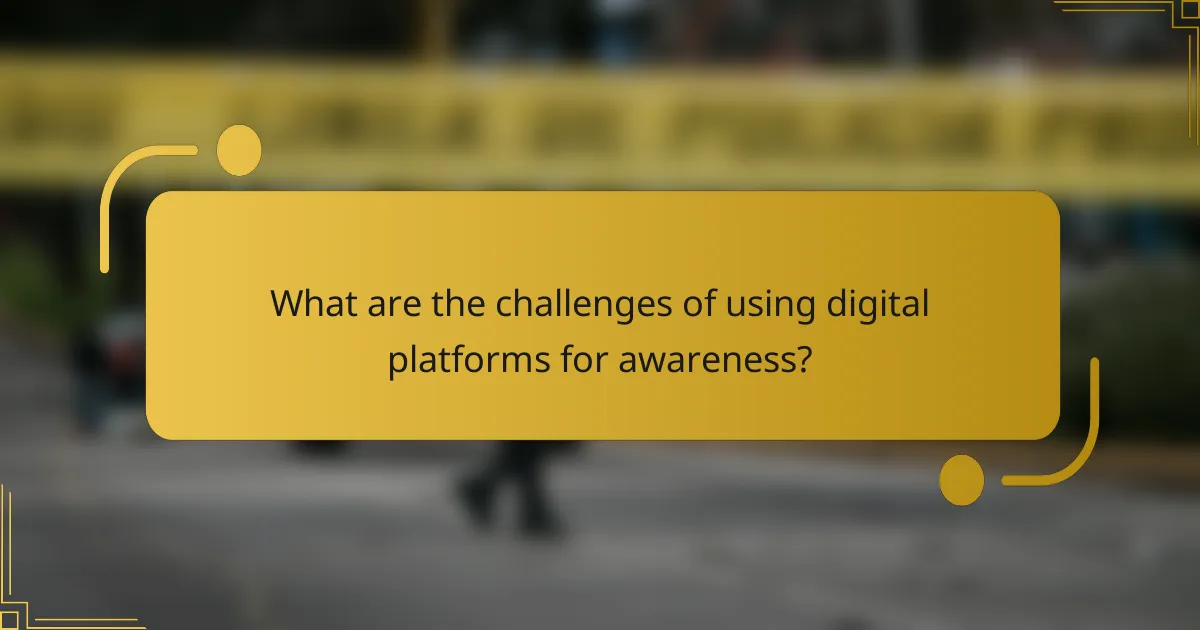
What are the challenges of using digital platforms for awareness?
Using digital platforms for awareness raising presents several challenges, including audience engagement, content saturation, and platform algorithms. Organizations must navigate these obstacles to effectively reach and influence their target audiences.
Audience engagement
Engaging an audience on digital platforms can be difficult due to the vast amount of content available. Users often scroll quickly through feeds, making it essential to capture attention within seconds. Strategies such as using eye-catching visuals, compelling headlines, and interactive content can help improve engagement rates.
Additionally, understanding the target audience’s preferences and behaviors is crucial. Tailoring content to resonate with specific demographics can enhance interaction and sharing, leading to greater awareness.
Content saturation
Content saturation occurs when users are overwhelmed by the sheer volume of information available online. This can lead to decreased attention spans and lower engagement levels. To combat this, organizations should focus on creating high-quality, unique content that stands out from the competition.
Utilizing storytelling techniques and emotional appeals can help make content more relatable and memorable. Regularly updating and refreshing content can also keep the audience interested and engaged over time.
Platform algorithms
Digital platforms often employ algorithms that determine which content is shown to users, impacting visibility and reach. Understanding these algorithms is essential for maximizing awareness efforts. For instance, platforms like Facebook and Instagram prioritize content that generates engagement, so creating shareable and interactive posts is vital.
Organizations should also consider diversifying their presence across multiple platforms to mitigate the risks associated with algorithm changes. Regularly analyzing performance metrics can provide insights into what works best and inform future strategies.
